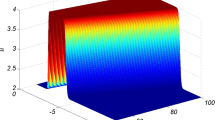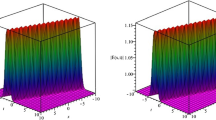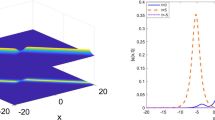Abstract
Seeking analytical solutions of nonlinear Schrödinger (NLS)-like equations remains an open topic. In this paper, we revisit the general inhomogeneous nonautonomous NLS (inNLS) equation and report on exact similaritons under generic constraint relationships by proposing a novel generic self-similar transformation, which implies that there exist a rich variety of highly controllable solution families for inhomogeneous systems. As typical examples, richly controllable behaviors of the self-similar soliton (SS), self-similar Akhmediev breather (SAB), self-similar Ma breather (SMB), and self-similar rogue wave (SRW) are presented in a periodic distribution nonlinear system. With the aid of a linear transformation, these novel similariton solutions are deployed as a basis for constructing two-component composite solutions to a pair of coherently coupled inNLS equations including four-wave mixing. The diverse composite waves that emerge, including SS–SS, SAB–SMB, and SRW–SRW families, are investigated in some detail. The family of similariton solutions presented here may prove significance for designing the control and transmission of nonlinear waves.







Similar content being viewed by others
Data availability
Our manuscript has no associated data.
References
Ponomarenko, S.A., Agrawal, G.P.: Do solitonlike self-similar waves exist in nonlinear optical media? Phys. Rev. Lett. 97, 013901 (2006)
Li, L., Zhao, X.S., Xu, Z.Y.: Dark solitons on an intense parabolic background in nonlinear waveguides. Phys. Rev. A 78, 063833 (2008)
Luo, H.G., Zhao, D., He, X.G.: Exactly controllable transmission of nonautonomous optical solitons. Phys. Rev. A 79, 063802 (2009)
Viscondi, T.F., Furuya, K.: Dynamics of a Bose-Einstein condensate in a symmetric triple-well trap. J. Phys. A: Math. Theor. 44, 175301 (2011)
Kruglov, V.I., Peacock, A.C., Harvey, J.D.: Exact self-similar solutions of the generalized nonlinear Schrödinger equation with distributed coefficients. Phys. Rev. Lett. 90, 113902 (2003)
Serkin, V.N., Hasegawa, A., Belyaeva, T.L.: Nonautonomous solitons in external potentials. Phys. Rev. Lett. 98, 074102 (2007)
Ding, C.C., Gao, Y.T., Deng, G.F., Wang, D.: Lax pair, conservation laws, Darboux transformation, breathers and rogue waves for the coupled nonautonomous nonlinear Schrödinger system in an inhomogeneous plasma. Chaos Solitons Fract. 133, 109580 (2020)
Wang, M., Tian, B.: In an inhomogeneous multicomponent optical fiber: Lax pair, generalized Darboux transformation and vector breathers for a three-coupled variable-coefficient nonlinear Schrödinger system. Eur. Phys. J. Plus. 136, 1002 (2021)
Yang, D.Y., Tian, B., Wang, M., Zhao, X., Shan, W.R., Jiang, Y.: Lax pair, Darboux transformation, breathers and rogue waves of an N-coupled nonautonomous nonlinear Schrödinger system for an optical fiber or a plasma. Nonlinear Dyn. 107, 2657–2666 (2022)
Yang, R.C., Gao, J., Jia, H.P., Tian, J.P., Christian, J.M.: Ultrashort nonautonomous similariton solutions and the cascade tunneling of interacting similaritons. Opt. Commun. 459, 125025 (2020)
Wu, X.F., Hua, G.S., Ma, Z.Y.: Novel rogue waves in an inhomogenous nonlinear medium with external potentials. Commun. Nonlinear Sci. Numer. Simul. 18, 3325–3336 (2013)
Perego, A.M.: Exact superregular breather solutions to the generalized nonlinear Schrödinger equation with nonhomogeneous coefficients and dissipative effects. Opt. Lett. 45(14), 3913 (2020)
Triki, H., Choudhuri, A., Zhou, Q., Biswas, A., Alshomrani, A.S.: Nonautonomous matter wave bright solitons in a quasi-1D Bose-Einstein condensate system with contact repulsion and dipole-dipole attraction. Appl. Math. Comput. 371, 124951 (2020)
Djoptoussia, C., Tiofack, C.G.L., AlimMohamadou, A., Kofané, T.C.: Ultrashort self-similar periodic waves and similaritons in an inhomogeneous optical medium with an external source and modulated coefficients. Nonlinear Dyn. 107, 3833–3846 (2022)
Liu, C.P., Fj, Yu., Li, L.: Non-autonomous wave solutions for the Gross-Pitaevskii (GP) equation with a parabola external potential in Bose-Einstein condensates. Phys. Lett. A 383, 125981 (2019)
Manikandan, K., Muruganandam, P., Senthilvelan, M., Lakshmanan, M.: Manipulating localized matter waves in multicomponent Bose-Einstein condensates. Phys. Rev. E 93, 032212 (2016)
Mareeswaran, R.B., Kanna, T.: Superposed nonlinear waves in coherently coupled Bose-Einstein condensates. Phys. Lett. A 380, 3244–3252 (2016)
Jia, H.P., Li, B., Yang, R.C., Tian, J.P.: Diverse composite waves in coherently coupled inhomogeneous fiber systems with external potentials. Nonlinear Dyn. 99(4), 2987–2999 (2020)
Xue, R.R., Yang, R.C., Jia, H.P., Wang, Y.: Novel bright and kink similariton solutions of cubic-quintic nonlinear Schrödinger equation with distributed coefficients. Phys. Scr. 96, 125230 (2021)
He, X.G., Zhao, D., Li, L., Luo, H.G.: Engineering integrable nonautonomous nonlinear Schrödinger equations. Phys. Rev. E 79, 056610 (2009)
Nandy, S., Barthakur, A.: Dark-bright soliton interactions in coupled nonautonomous nonlinear Schrödinger equation with complex potentials. Chaos Soliton. Fract. 143, 110560 (2021)
Agrawal, G.P.: Nonlinear Fiber Optics, 4th edn. Academic Press, New York (2007)
Chabchoub, A., Hoffmann, N.P., Akhmediev, N.: Rogue wave observation in a water wave tank. Phys. Rev. Lett. 106(20), 204502 (2011)
Chabchoub, A., Hoffmann, N., Onorato, M., Akhmediev, N.: Super rogue waves: observation of a higher-order breather in water waves. Phys. Rev. X 2(1), 011015 (2012)
Akhmediev, N., Ankiewicz, A., Soto-Crespo, J.M.: Rogue waves and rational solutions of the nonlinear Schrödinger equation. Phys. Rev. E 80, 026601 (2009)
Ankiewicz, A., Kedziora, D.J., Akhmediev, N.: Rogue wave triplets. Phys. Lett. A 375, 2782–2785 (2011)
Kengne, E., Lakhssassi, A., Liu, W.M.: Non-autonomous solitons in inhomogeneous nonlinear media with distributed dispersion. Nonlinear Dyn. 97, 449–469 (2019)
Loomba, S., Kaur, H.: Optical rogue waves for the inhomogeneous generalized nonlinear Schrödinger equation. Phys. Rev. E 88, 062903 (2013)
Kundu, A.: Integrable nonautonomous nonlinear Schrödinger equations are equivalent to the standard autonomous equation. Phys. Rev. E 79, 015601 (2009)
Zhao, D., He, X.G., Luo, H.G.: From canonical to nonautonomous solitons. Eur. Phys. J. D 53, 213–216 (2009)
Triki, H., Zhou, Q., Biswas, A., Xu, S.L., Alzahrani, A.K., Belic, M.R.: Self-frequency shift effect for chirped self-similar solitons in a tapered graded-indexed waveguide. Opt. Commun. 468, 125800 (2020)
Dai, C.Q., Wang, Y.Y., Tian, Q., Zhang, J.F.: The management and containment of self-similar rogue waves in the inhomogeneous nonlinear Schrödinger equation. Ann. Phys. 327, 512–521 (2012)
Kumar, C.N., Gupta, R., Goyal, A., Loomba, S., Raju, T.S., Panigrahi, P.K.: Controlled giant rogue waves in nonlinear fiber optics. Phys. Rev. A 86, 025802 (2012)
Ponomarenko, S.A., Agrawal, G.P.: Optical similaritons in nonlinear waveguides. Opt. Lett. 32, 1659 (2007)
Kengne, E., Liu, W.M.: Management of matter-wave solitons in Bose-Einstein condensates with time-dependent atomic scattering length in a time-dependent parabolic complex potential. Phys. Rev. E 98, 012204 (2018)
Zhang, J.F., Hu, W.C.: Controlling the propagation of optical rogue waves in nonlinear graded-index waveguide amplifiers. Chin. Opt. Lett. 11(3), 031901 (2013)
Kruglov, V.I., Triki, H.: Quartic and dipole solitons in a highly dispersive optical waveguide with self-steepening nonlinearity and varying parameters. Phys. Rev. A 102, 043509 (2020)
Triki, H., Kruglov, V.I.: Chirped self-similar solitary waves in optical fibers governed with self-frequency shift and varying parameters. Chaos Soliton. Fract. 143, 110551 (2021)
Jia, H.P., Yang, R.C., Tian, J.P., Zhang, W.M.: Controllable excitation of higher-order rogue waves in nonautonomous systems with both varying linear and harmonic external potentials. Opt. Commun. 415, 93–100 (2018)
Mahato, D.K., Govindarajan, A., Lakshmanan, M., Sarma, A.K.: Dispersion managed generation of Peregrine solitons and Kuznetsov-Ma breather in an optical fiber. Phys. Lett. A 392, 127134 (2021)
Tiofack, C.G.L., Coulibaly, S., Taki, M., Bièvre, S.D., Dujardin, G.: Periodic modulations controlling Kuznetsov–Ma soliton formation in nonlinear Schrödinger equations. Phys. Lett. A 381, 1999–2003 (2017)
Zhao, D., Luo, H.G., Chai, H.Y.: Integrability of the Gross-Pitaevskii equation with Feshbach resonance management. Phys. Lett. A 372, 5644 (2008)
Manikandan, K., Muruganandam, P., Senthilvelan, M., Lakshmanan, M.: Manipulating matter rogue waves and breathers in Bose-Einstein condensates. Phys. Rev. E 90, 062905 (2014)
He, J., Li, Y.: Designable integrability of the variable coefficient nonlinear Schrödinger equations. Stud. Appl. Math. 126, 1–15 (2011)
Manikandan, K., Priya, N.V., Senthilvelan, M., Sankaranarayanan, R.: Higher-order matter rogue waves and their deformations in two-component Bose-Einstein condensates. Wave. Random Complex 32, 867–886 (2022)
Hao, R.R., Li, L., Li, Z.H., Zhou, G.S.: Exact multisoliton solutions of the higher-order nonlinear Schrödinger equation with variable coefficients. Phys. Rev. E 70, 066603 (2004)
Yang, R.C., Li, L., Hao, R.Y., Li, Z.H., Zhou, G.S.: Combined solitary wave solutions for the inhomogeneous higher-order nonlinear Schrödinger equation. Phys. Rev. E 71, 036616 (2005)
Chabchoub, A., Hoffmann, N., Onorato, M., Slunyaev, A., Sergeeva, A., Pelinovsky, E., Akhmediev, N.: Observation of a hierarchy of up to fifth-order rogue waves in a water tank. Phys. Rev. E 86, 056601 (2012)
Funding
This work was supported by the National Natural Science Foundation of China (Grant numbers. 61775126, 62071282).
Author information
Authors and Affiliations
Contributions
KH was involved in methodology, software, data analysis, writing—original draft. RY contributed to conceptualization, theoretical analysis, supervision. HJ was involved in conceptualization, validation, writing—review & editing. YH and JMC contributed to writing-review & editing.
Corresponding author
Ethics declarations
Conflict of interest
The authors have no relevant financial or non-financial interests to disclose.
Additional information
Publisher's Note
Springer Nature remains neutral with regard to jurisdictional claims in published maps and institutional affiliations.
Appendices
Appendix A: Explicit self-similar solutions of Eq. (1)
The explicit solutions of SS, SAB, SMB and SRW for inNLS Eq. (1) can be obtained by combining Eqs. (11)–(16) and the exact solutions of the soliton [22], Akhmediev and Ma breather [23], and rogue wave (RW) [24] of Eq. (8), which are expressed as follows:
(1) Exact SS solution:
where ηs, δs, Ts and ϕs represent the amplitude, frequency, initial position and phase of the SS, respectively.
(2) Exact SAB solution
where a = 2sin(2ωab), b = 2sin(ωab), ωab ∈ ℝ. The parameters Zab and Tab are, respectively, related to the initial position and time-shift of the SAB.
(3) Exact SMB solution
where ma = 2sinh(2ωm), mb = 2sinh(ωm), ωm ∈ ℝ. The parameters Zm and Tm determine the initial position and time-shift of the SMB, respectively.
(4) Exact SRW solution
where αg is related to the background intensity of the SRW. The parameters Zg and Tg determine the initial position and time-shift of the SRW, respectively. Here, the self-similar variables Z ≡ Z(z) and T ≡ T(z, t) in (A1)–(A4) are given by Eqs. (12) and (13), respectively.
Appendix B: Some special cases of similariton (2)
(1) When αp = 0, 5αd = –3αr, r5(z) = d3(z) and Ω0 = 0, under the constraint conditions Γ(z) = 0 and Ω2(z) = [–8dz2(z) + 5d(z)dzz(z)] /[50d3(z)], the self-similar variables are reduced to those studied in Ref. [11]:
(2) When αp = 0, αr = 0, αd = − 1/2 and Ω0(z) = 0, under the constraint conditions Γ(z) = –dz(z)/2d(z) and Ω2(z) = [r(z)rz(z)dz(z) + 2d(z)rz2(z) – d(z)r(z)rzz(z), the self-similar variables are reduced to the first case reported in Ref. [18]:
(3) When αp = 0, αr = 1/2, αd = − 1/2 and Ω0(z) = 0, under the constraint conditions Ω2(z) = 0 and Γ(z) = rz(z)/2r(z) – dz(z)/2d(z), the self-similar variables are reduced to those reported in Refs. [12, 18]:
(4) When αp = 1/2, αr = 0, αd = 0, p(z) = wz(z)/w(z) and d(z) = r(z) = 1, Ω0(z) = Ω1(z) = 0, under the constraint conditions Γ(z) = wz(z)/2w(z) and Ω2(z) = wzz(z)/4w(z), the self-similar variables are reduced to those reported in Refs. [33, 34]:
It should be pointed out that there is a slight difference among Appendix B and Refs. [11, 12, 18, 33, 34] due to the different coefficients used in the theory.
Rights and permissions
Springer Nature or its licensor (e.g. a society or other partner) holds exclusive rights to this article under a publishing agreement with the author(s) or other rightsholder(s); author self-archiving of the accepted manuscript version of this article is solely governed by the terms of such publishing agreement and applicable law.
About this article
Cite this article
Huo, K., Yang, R., Jia, H. et al. Exact similariton solution families and diverse composite waves in coherently coupled inhomogeneous systems. Nonlinear Dyn 111, 14435–14451 (2023). https://doi.org/10.1007/s11071-023-08574-9
Received:
Accepted:
Published:
Issue Date:
DOI: https://doi.org/10.1007/s11071-023-08574-9




